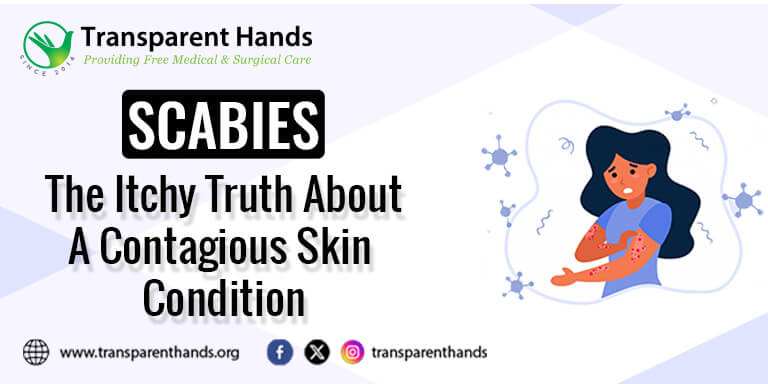Scabies: The Itchy Truth About a Contagious Skin Condition

Scabies, a microscopic mite infestation, might be extremely small in size, but its impact on the skin and well-being can be significant. Understanding how to identify scabies, discerning its contagious nature, and adopting preventive measures are crucial steps in managing this dermatological challenge.
In this comprehensive guide, we take a look at the mysteries surrounding scabies, exploring its identification, contagiousness, and preventive strategies to equip individuals with the knowledge to stay safe from it.
How to Identify Scabies?
Identifying scabies involves recognizing its characteristic signs and symptoms. The most common indicators include:
Intense Itching: One of the hallmark signs of scabies is relentless itching, often worsening at night. The microscopic mites burrow into the skin, laying eggs and triggering an allergic reaction that leads to itching. The itching is much worse at night or after a hot shower. Think sandpaper meets a persistent mosquito, and you’ll get the picture.
Red, Pimple-Like Rash: A rash, consisting of small, red bumps or blisters, is a key visual cue. The rash tends to appear in the folds of the skin, such as between fingers, wrists, elbows, and genitals.
Tracks or Burrows: Thin, irregular lines on the skin, known as burrows, may be visible. These burrows represent the mites’ tunnels beneath the skin’s surface.
Secondary Infections: Scratching the intensely itchy areas can lead to open sores, increasing the risk of secondary bacterial infections.
If you suspect scabies based on these symptoms, it is imperative to seek prompt medical attention for a definitive diagnosis.
Castor Oil in Treating Cysts and Lumps
Is Scabies Contagious?
Yes, scabies is contagious, and its transmission primarily occurs through prolonged, skin-to-skin contact with an infected individual. This happens often during activities like cuddling, sleeping together, or even shaking hands. The mites can also spread through infested clothing, bedding, or towels. While scabies can affect anyone, it is particularly common in crowded environments, institutions, and households.
What are the Causes of Scabies?
The microscopic culprit responsible for scabies is the Sarcoptes scabiei mite. These tiny arachnids burrow into the outer layer of the skin, where they lay eggs and cause the characteristic symptoms of scabies. The intense itching associated with scabies is a result of the body’s allergic reaction to the mites and their waste.
Contrary to popular belief, scabies doesn’t discriminate – anyone can contract it, regardless of hygiene habits. Scabies thrives on contact, not dirt or poor hygiene.
The Prevention of Scabies
Preventing scabies involves adopting measures to reduce the risk of mite transmission. Here are key preventive strategies:
Maintain Personal Hygiene: Regular bathing and maintaining clean personal spaces can reduce the risk of scabies infestation. Wash hands frequently with soap and water, especially after contact with someone suspected of having scabies.
Avoid Prolonged Skin-to-Skin Contact: Minimize direct skin contact with individuals who have scabies, especially in crowded settings.
Wash Bedding and Clothing: Regularly launder bedding, clothing, and towels in hot water to eliminate any potential mites and their eggs.
Isolate Infected Individuals: Individuals diagnosed with scabies should avoid close contact with others until treatment is complete. If you suspect you or someone you know has scabies, avoid close physical contact to prevent spreading.
Seek medical attention: Early diagnosis and treatment with prescribed medicated creams or lotions are crucial to curb the infection and prevent complications.
The Treatment of Scabies
Once scabies is identified, prompt treatment is crucial to eliminate the mites and alleviate symptoms. Common treatment approaches include:
Topical Medications: Prescription creams or lotions containing permethrin or ivermectin are commonly used to kill the mites.
Oral Medications: In some cases, oral medications may be prescribed for severe infestations.
Antihistamines: These may be recommended to alleviate itching and improve sleep.
Conclusion
In conclusion, understanding how to identify scabies, acknowledging its contagious nature, and embracing preventive measures are pivotal for managing this dermatological concern. It might be an unwelcome guest, but understanding its signs, knowing its contagious nature, and taking preventive measures can help you keep it at bay. By acknowledging its presence, seeking timely treatment, and practicing good hygiene, you can scratch those itchy woes away and reclaim your smooth, healthy skin.
If you suspect scabies or experience persistent itching and skin changes, consult a healthcare professional for a thorough evaluation and tailored scabies treatment. Through awareness, timely intervention, and preventive measures, we can collectively work towards minimizing the impact of scabies and fostering a skin-friendly environment for all.
(The information in this article should not be taken as a substitute for professional medical advice)










Leave Your Comments